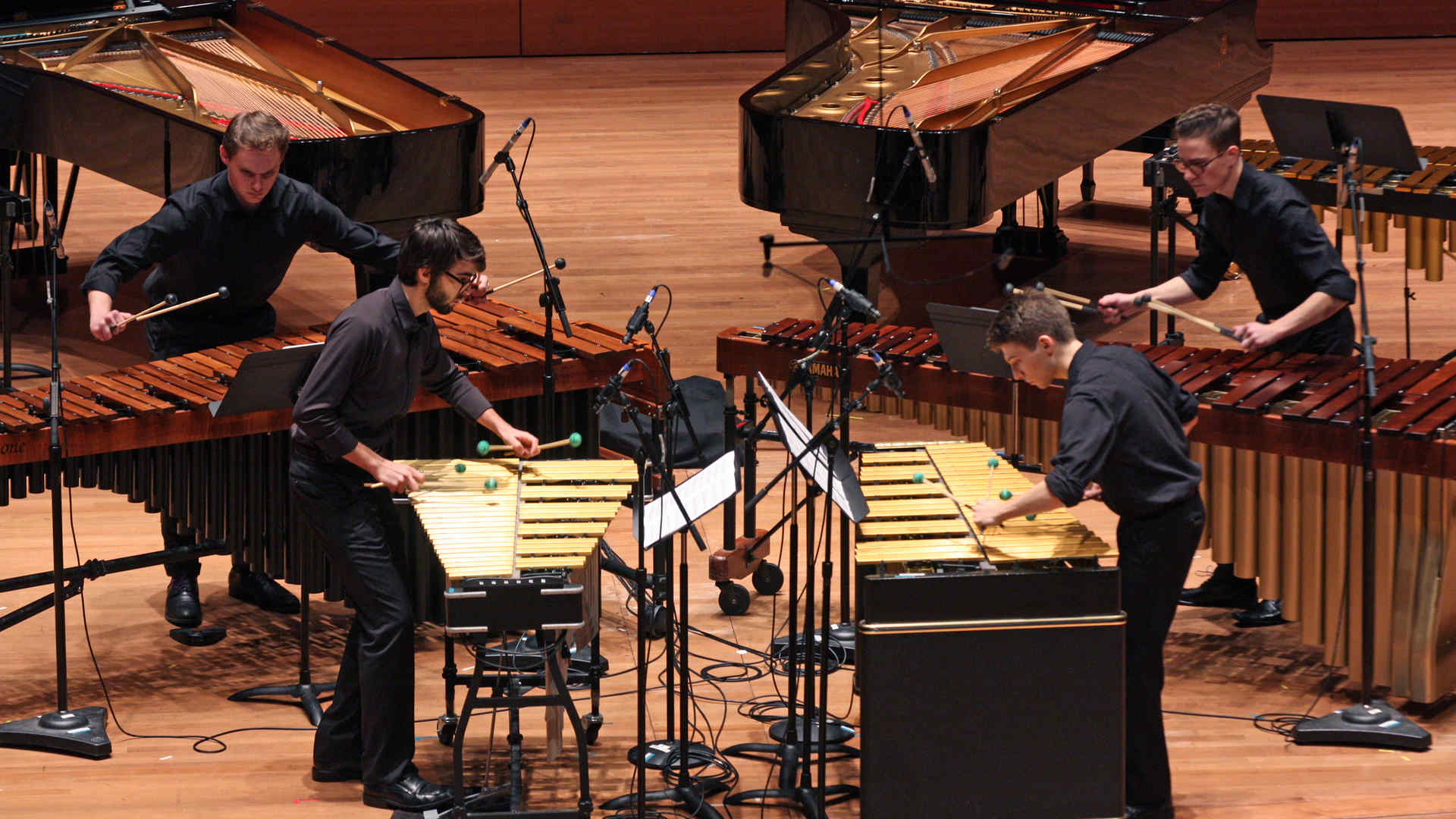
Percussion Ensemble
Princeton University has long been a dynamic, vibrant environment for composers. Following years of guidance under Roger Sessions (Juilliard faculty 1965-83) and Milton Babbitt (Juilliard faculty 1971-2008), the Princeton composition department began to embrace a more robust eclecticism championed by the forward thinking and open-mindedness of Paul Lansky and Steven Mackey, and the more recent hires of Barbara White, Dan Trueman, Juri Seo, and Donnacha Dennehy further enhanced this trend. The presence of Sō Percussion as artists in residence at Princeton for the last few years has created an enhanced awareness of percussion ensemble repertoire and inspired both faculty and students with the sonic possibilities of this idiom. The result is a fascinating growing body of work for percussion. On December 3, the Juilliard Percussion Ensemble explores this legacy.
Any percussion concert featuring music from Princeton needs to start with the music of Steven Mackey, whose unabashed lyricism, wicked sense of humor, and eclectic mix of influences from the pop, rock, and classical realms embody the spirit of adventure and inclusivity so prevalent at this institution. Our concert features Madrigal (2014), for female voice and percussion quartet, for which Mackey wrote the text and music “to allow a negotiation between the melodic line, harmony, and words, rather than setting a pre-existing immutable poem,” he said. “In this sense the text becomes partly an orchestrational decision made by shaping the singer’s mouth. The choice between a word with a long O sound versus one with a long A sound is like deciding between a trumpet and a clarinet. This process also afforded me with occasions to use text to reinforce ad hoc and asymmetrical rhymes in the harmony and vice versa.”
Irish-born composer Donnacha Dennehy wrote Surface Tension (2015-16) for and with Third Coast Percussion, a Chicago-based quartet. Inspired by the pitch-bending melodic possibilities of indigenous hand drums such as the Middle Eastern tar or Irish bodhrán, the piece seeks to make unpitched drums “sing.” Rubber tubes are inserted into the air holes in the drums and the performers blow on the tubes, changing the tension within the drum and therefore altering the pitch while playing with both hands. The result is a kind of pulsating glissando that shifts in and out of specific overtone-based tonalities.
Juri Seo seeks to merge aspects of music from the past century—in particular its expanded timbral palette and unorthodox approach to structure—with a deep love of functional tonality, counterpoint, and classical form. Four for Flexatones (2009) is a tongue-in-cheek, categorical exploration of all the sonic possibilities of the quirky flexatone.
Caroline Shaw, a Juilliard Creative Associate, Princeton alumna, vocalist, violinist, producer, and composer, received the Pulitzer Prize for music in 2013. A member of the vocal octet Roomful of Teeth, she has become increasingly sought-after in the classical, crossover, and film realms. After she wrote taxidermy, for Sō Percussion, she noted that the word taxidermy “evokes something grand, awkward, epic, silent, funny, and just a bit creepy— all characteristics of this piece. The repeated phrase toward the end (‘the detail of the pattern is movement’) is a little concept I love trying (and failing) to imagine. It comes from T.S. Eliot’s beautiful and perplexing “Burnt Norton” (from the Four Quartets), and I’ve used it before in other work—as a kind of whimsical existentialist mantra.”
While writing Four Drums for Dresden (2010) for four drum kits, British/American composer and Princeton alumnus Oscar Bettison realized that “our concept of ‘drums’ has changed over the last 30 years or so with the advent of drum machines and drum programming. The same sounds (cymbals, snare, and kick) are used in both acoustic and electronic drums, but things that are not necessarily playable by one drummer are common in all sorts of electronic music. Indeed, several genres of dance music have been founded on the very fact that electronic drums are an instrument [that’s] unfettered by the perceived limitations of human performers.” In this piece, he added, the four drummers “combine, contrapuntally, to make up a kind of meta-drummer. The irony that by adding more humans one can get closer to what a machine can do is, for me, what the piece is about.”
Eclectic composer and performer Andy Akiho’s recent commissions include works for the New York Philharmonic, National Symphony Orchestra, Shanghai Symphony Orchestra, and the Juilliard-Carnegie Hall Ensemble Connect. His works, which adroitly straddle the divide between classical and pop music, are often influenced by the timbre and energy of his own instrument, the steel pan. Akiho, a doctoral candidate at Princeton, wrote Pillar IV (2012) for the Time Travelers percussion quartet, and it’s become iconic in the percussion ensemble repertoire. In it conventional instruments are played in unconventional fashion (i.e. with drumsticks instead of mallets, from the back of the instrument rather than the front, on the shell of the drum instead of the head) and combined with unpitched metals, woods, bottles, and pipes to create a busy, percolating, relentless groove.
Daniel Druckman (Pre-College ’76; BM and MM ’80, percussion) is chair of the percussion department